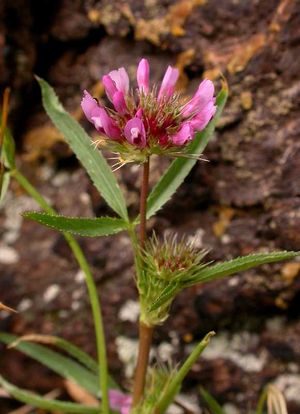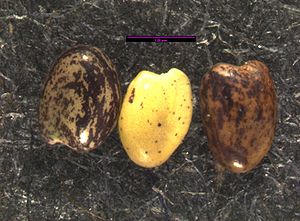Difference between revisions of "Trifolium willdenovii"
(→Taxonomy) (Tag: VisualEditor) |
(→Description) (Tag: VisualEditor) |
||
| Line 31: | Line 31: | ||
Herbarium, Burke Museum, & University of Washington. Retrieved from https://biology.burke.washington.edu/herbarium/imagecollection/taxon.php?Taxon=Trifolium%20willdenovii</ref> Stems spreading to erect, 1 to several.<ref name="University of Idaho">E-Flora | Herbarium, Burke Museum, & University of Washington. Retrieved from https://biology.burke.washington.edu/herbarium/imagecollection/taxon.php?Taxon=Trifolium%20willdenovii</ref> Stems spreading to erect, 1 to several.<ref name="University of Idaho">E-Flora | ||
BC: Electronic Atlas of the Flora of British Columbia. Retrieved from http://linnet.geog.ubc.ca/Atlas/Atlas.aspx?sciname=Trifolium+willdenovii</ref> Leaves alternate,<ref name="University of Idaho" /> trifoliate, petiolate with narrow leaflets to 4 cm long, serrulate; stipules large, ovate, lacerate.<ref name=":0" /> Inflorescences head-like, involucre greater than 3 mm,<ref name=":1">Hitchcock, C. L., Cronquist, A., Giblin, D., | BC: Electronic Atlas of the Flora of British Columbia. Retrieved from http://linnet.geog.ubc.ca/Atlas/Atlas.aspx?sciname=Trifolium+willdenovii</ref> Leaves alternate,<ref name="University of Idaho" /> trifoliate, petiolate with narrow leaflets to 4 cm long, serrulate; stipules large, ovate, lacerate.<ref name=":0" /> Inflorescences head-like, involucre greater than 3 mm,<ref name=":1">Hitchcock, C. L., Cronquist, A., Giblin, D., | ||
| − | & Legler, B. et al. (2018). ''Flora of the Pacific Northwest: an | + | & Legler, B. et al. (2018). ''Flora of the Pacific Northwest: an'' |
| − | illustrated manual''. Seattle: University of Washington Press. pp. 177-179.</ref> 1-3 cm wide with 6-60 flowers.<ref name="University of Idaho" /> Flowers papilionaceous; calyx shiny,<ref name=":2">Jepson Herbarium Online Flora. Retrieved from https://ucjeps.berkeley.edu/eflora/eflora_display.php?tid=47186</ref> 5-lobes equal in length to tube;<ref name=":0" /> corolla 5-merous with banner, wings and connate keel, purple, 8-15 mm;<ref name=":2" /> stamens 10, diadelphous; pistil simple, | + | illustrated manual''. Seattle: University of Washington Press. pp. 177-179.''</ref> 1-3 cm wide with 6-60 flowers.<ref name="University of Idaho" /> Flowers papilionaceous; calyx shiny,<ref name=":2">Jepson Herbarium Online Flora. Retrieved from https://ucjeps.berkeley.edu/eflora/eflora_display.php?tid=47186</ref> 5-lobes equal in length to tube;<ref name=":0" /> corolla 5-merous with banner, wings and connate keel, purple, 8-15 mm;<ref name=":2" /> stamens 10, diadelphous; pistil simple, superior ovary becoming a 1 to 2-seeded capsule.<ref name=":1" /> |
===Bloom Period=== | ===Bloom Period=== | ||
Latest revision as of 10:43, 30 June 2021
- Scientific Name: Trifolium willdenovii
- Family: Fabaceae.
- Common Names: tomcat clover, sand clover.
- Synonyms and misapplications: Trifolium tridentatum
- Codon: TRIWIL
Contents
Taxonomy
| Scientific classification | |
|---|---|
| Kingdom: | Plantae |
| Subkingdom: | Viridiplantae |
| Phylum: | Tracheophyta |
| Subphylum: | Spermatophytina |
| Class: | Magnoliopsida |
| Subclass: | Lilianeae |
| Order: | Fabales |
| Family: | Fabaceae |
| Genus: | Trifolium L. |
| Species: | Trifolium willdenovii V.G. Soukup |
| Synonyms | |
| |
Description
Glabrous annual herb, growing from a taproot with terminal heads of purplish flowers, up to 70 cm tall.[2] Stems spreading to erect, 1 to several.[3] Leaves alternate,[3] trifoliate, petiolate with narrow leaflets to 4 cm long, serrulate; stipules large, ovate, lacerate.[2] Inflorescences head-like, involucre greater than 3 mm,[4] 1-3 cm wide with 6-60 flowers.[3] Flowers papilionaceous; calyx shiny,[5] 5-lobes equal in length to tube;[2] corolla 5-merous with banner, wings and connate keel, purple, 8-15 mm;[5] stamens 10, diadelphous; pistil simple, superior ovary becoming a 1 to 2-seeded capsule.[4]
Bloom Period
April-July[2]
Distribution
British Columbia south to California; in Washington, west side of the Cascades and east along the Columbia River.[2]
Habitat
Low to moderate elevation grassy hillsides, balds, prairies and meadows.[2]
Uses
Seeds used for food; Young, tender plants eaten uncooked as greens; Raw or steamed buds eaten before plant bloomed; Steamed, dried leaves soaked in water or boiled before eating in winter. [6]
Propagation
Seeds are germinated during late winter and early spring months in a shadehouse were they remain for several weeks. Seeds are directly sown into flats filled with a 1 inch layer of special seed germination mix of 1:1 (v:v) Sunshine Professional Growing Mix and sand on top of 4:1:1 (v:v:v) peat, perlite, and organic compost.[7]
Seed
Seed sample from: 2011
Average Measurement: 1.6 x 1.1 x 1.1
Measurement Range: L: 1.5 - 2, W: 1 - 1.3, D: 1 - 1.1
Features
Shape: Flattened egg shape. Hilum is small circular divot seated between a protruding lobe.
Color: Seed background gray/brown, sometimes speckled with dark brown.
Surface: Smooth and glossy.
Latitudinal Cross Section: elliptical ![]()
Longitudinal Cross Section: elliptical ![]()
Basic Explanations and Assumptions:
The dimensions for the seeds are length x width x depth. The location of the hilum is used as the base of the seed, and the length is measured from hilum to the opposite apex. Where a style is present, the length is measured from the hilum to the bottom of the style. Width is measured at a right angle to the length at the widest part. Depth is measured at a right angle to the intersection of height and width lines.
Measurements included are the mean average for each measurement of ten separate seeds.
All measurements in millimeters unless otherwise noted.
Photo Gallery
References
Herrera, Mike; Takara, Janet. 2006. Propagation protocol for production of container Trifolium willdenovi Spreng. ' ' plants (Deepot 40 (40 cubic inch)); Catalina Island Conservancy, Avalon, California. In: Native Plant Network. URL: http://www.nativeplantnetwork.org (accessed 25 September 2006). Moscow (ID): University of Idaho, College of Natural Resources, Forest Research Nursery. http://biology.burke.washington.edu/herbarium/imagecollection.php
- ↑ Interagency Taxonomic Information System. Retrieved from https://www.itis.gov/servlet/SingleRpt/SingleRpt?search_topic=TSN&search_value=26315#null
- ↑ 2.0 2.1 2.2 2.3 2.4 2.5 WTU Herbarium, Burke Museum, & University of Washington. Retrieved from https://biology.burke.washington.edu/herbarium/imagecollection/taxon.php?Taxon=Trifolium%20willdenovii
- ↑ 3.0 3.1 3.2 E-Flora BC: Electronic Atlas of the Flora of British Columbia. Retrieved from http://linnet.geog.ubc.ca/Atlas/Atlas.aspx?sciname=Trifolium+willdenovii
- ↑ 4.0 4.1 Hitchcock, C. L., Cronquist, A., Giblin, D., & Legler, B. et al. (2018). Flora of the Pacific Northwest: an illustrated manual. Seattle: University of Washington Press. pp. 177-179.
- ↑ 5.0 5.1 Jepson Herbarium Online Flora. Retrieved from https://ucjeps.berkeley.edu/eflora/eflora_display.php?tid=47186
- ↑ [1]
- ↑ Herrera, Mike; Takara, Janet. 2006. Propagation protocol for production of container Trifolium willdenovi Spreng. ' ' plants (Deepot 40 (40 cubic inch)); Catalina Island Conservancy, Avalon, California. In: Native Plant Network. URL: http://www.nativeplantnetwork.org (accessed 25 September 2006). Moscow (ID): University of Idaho,





